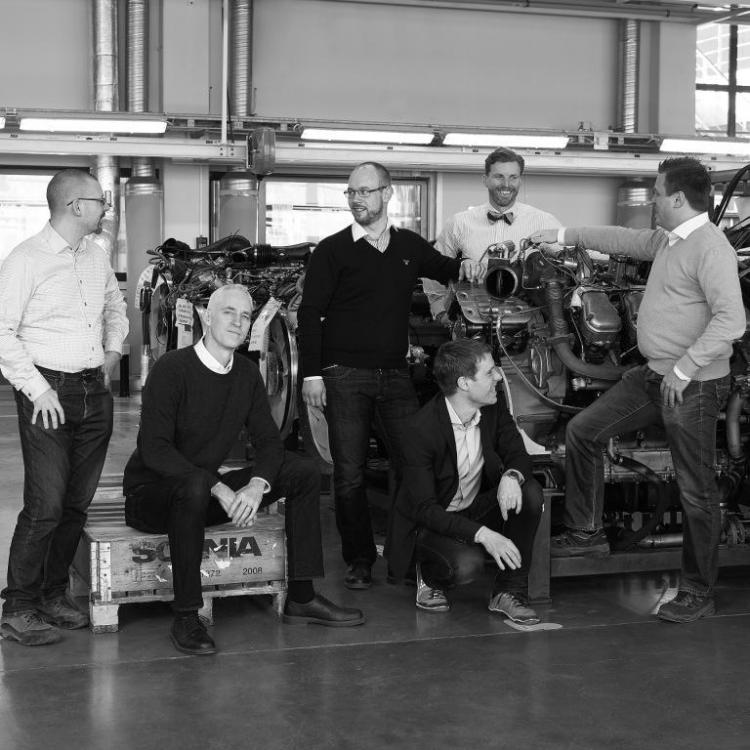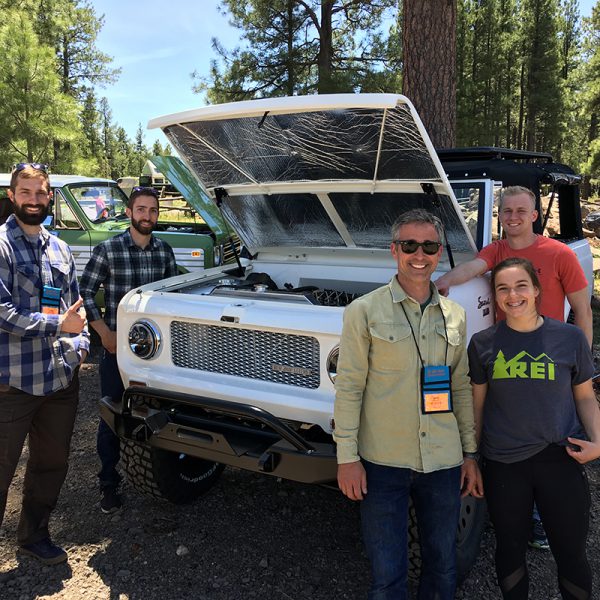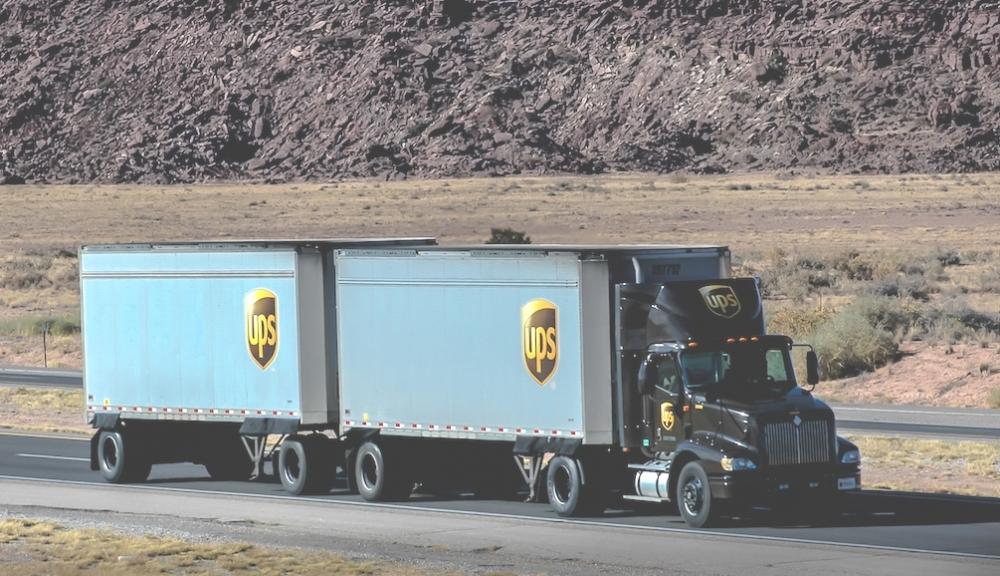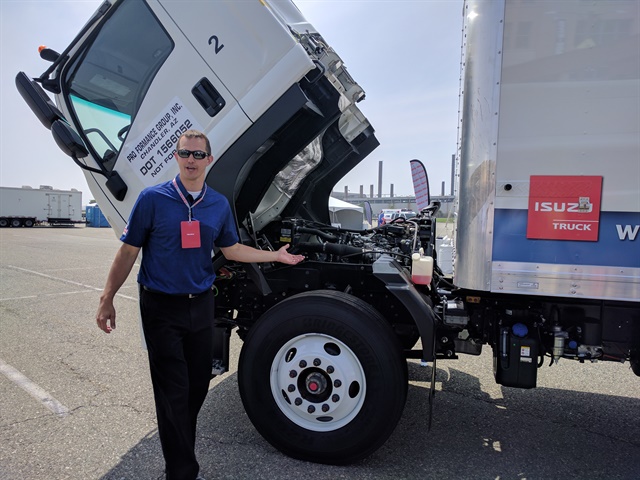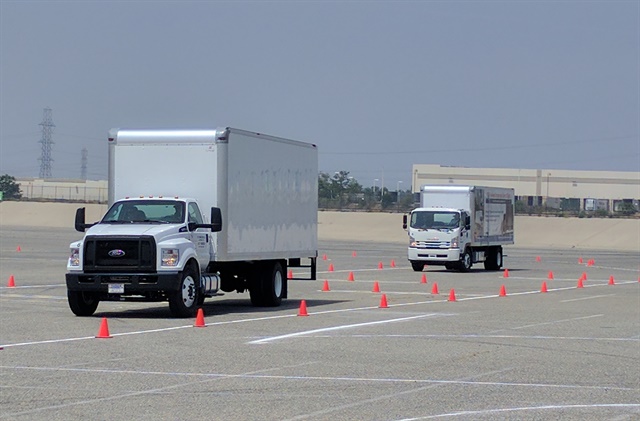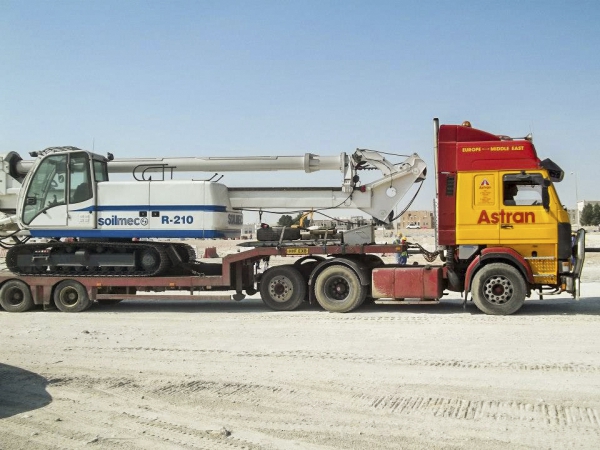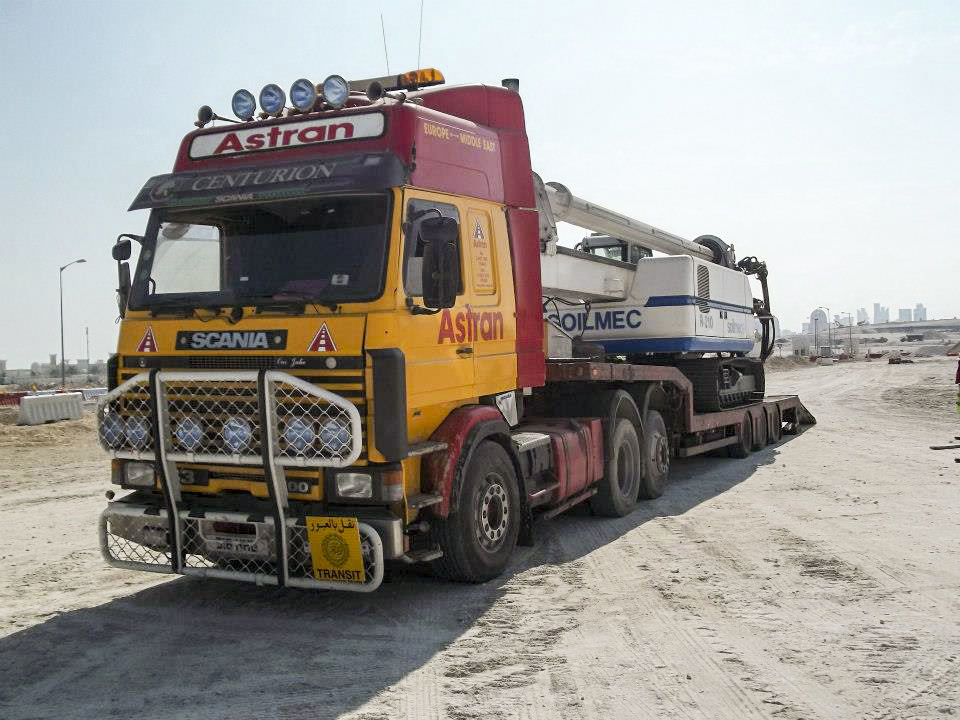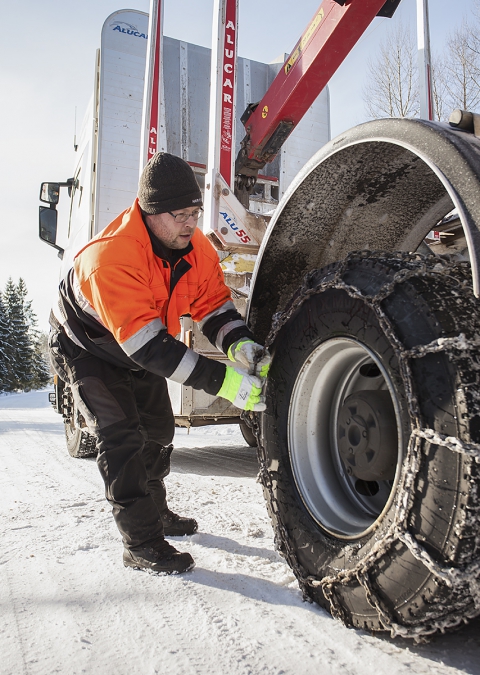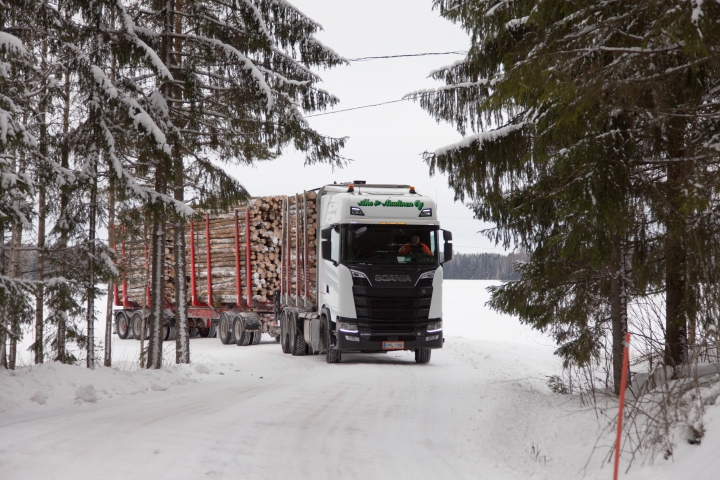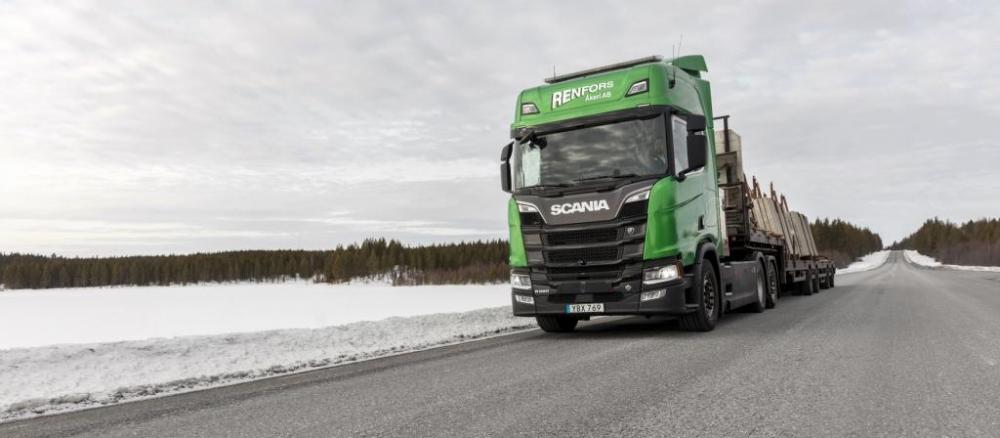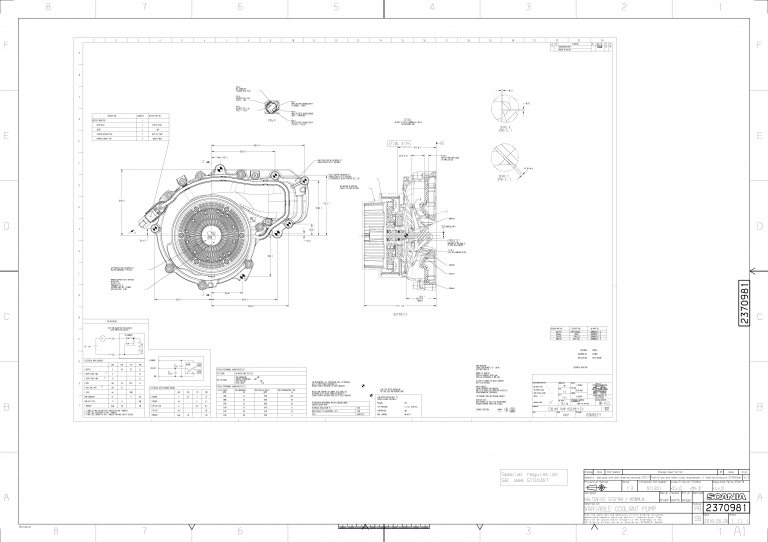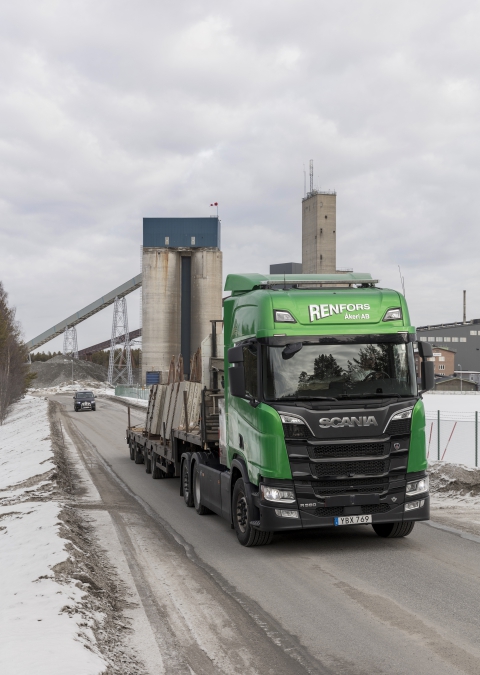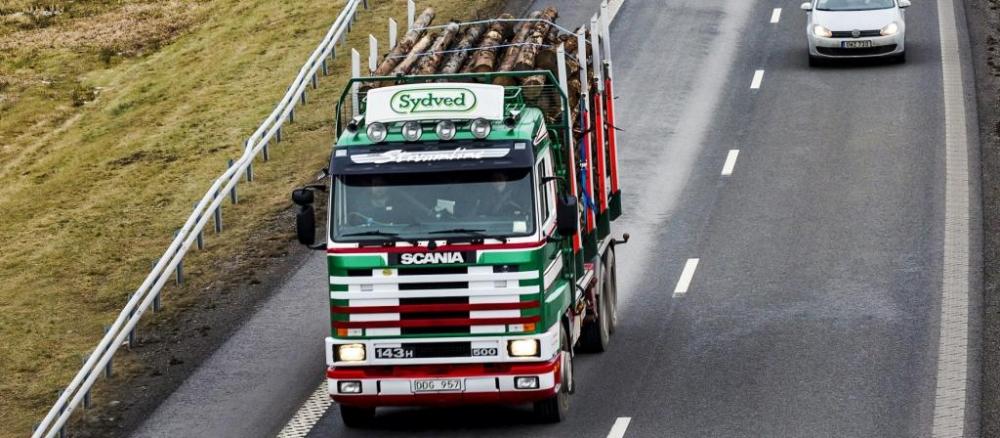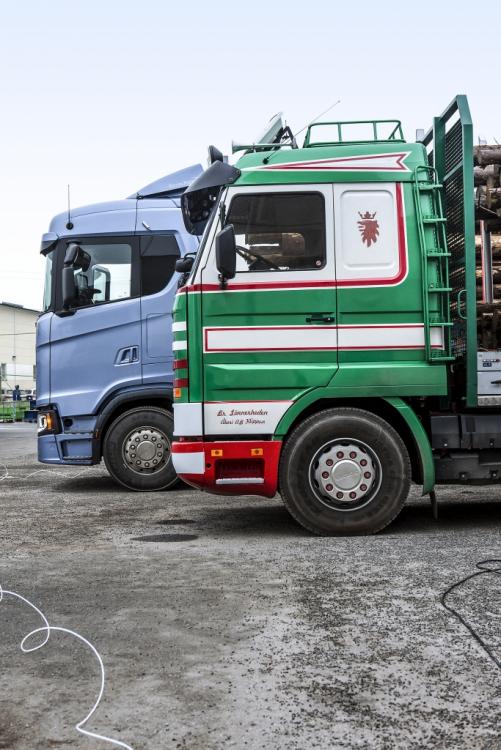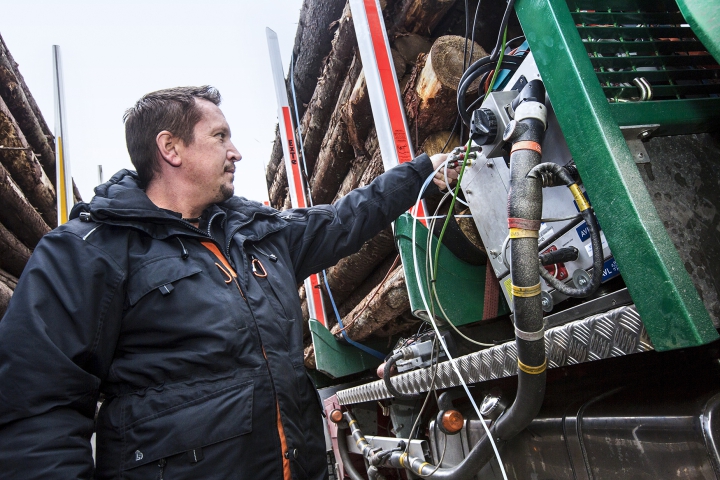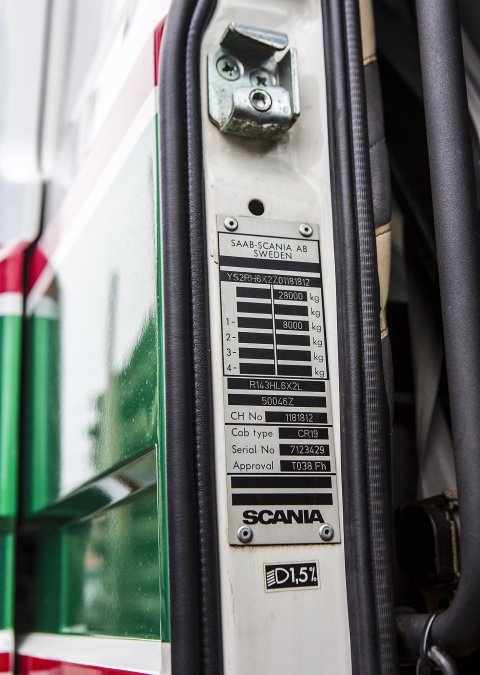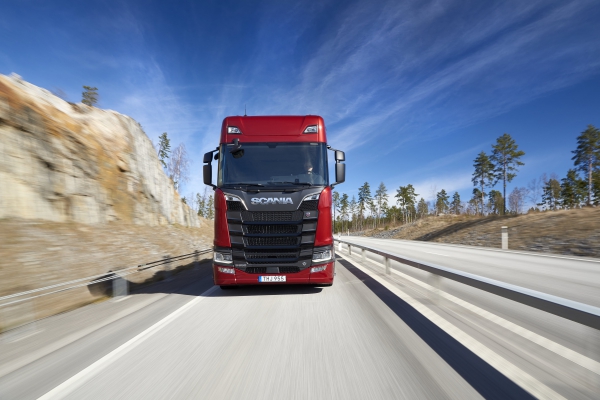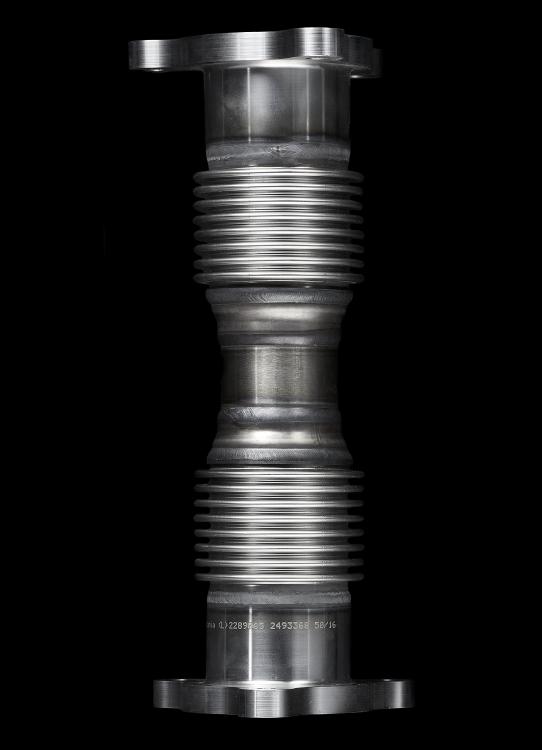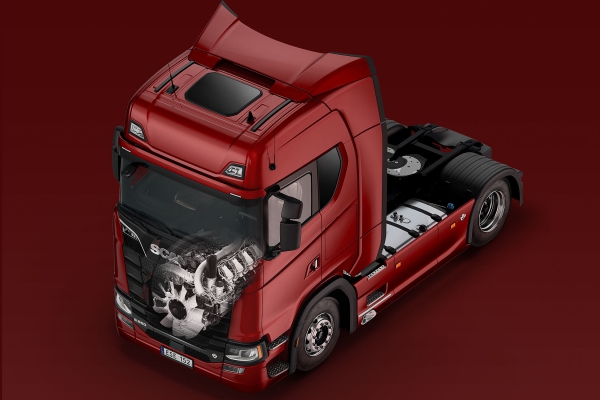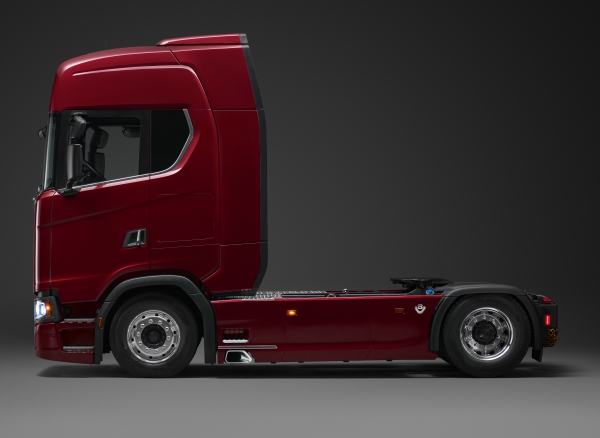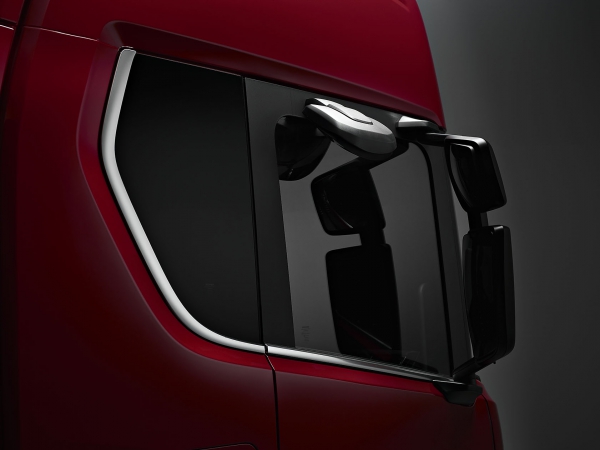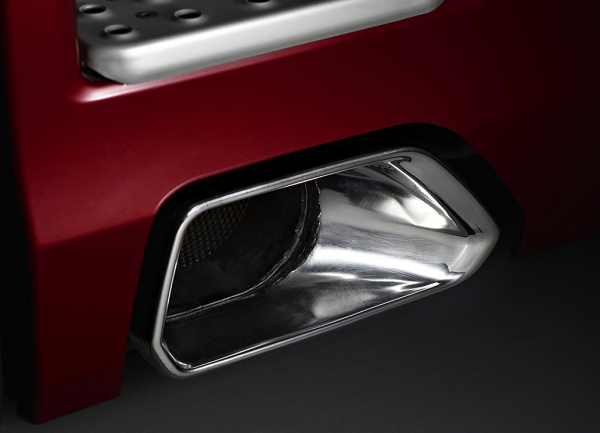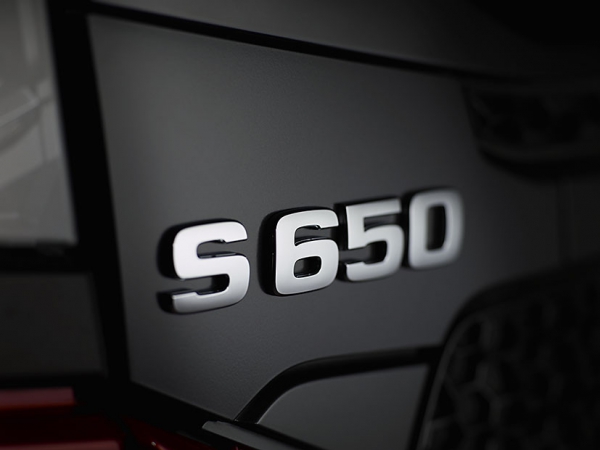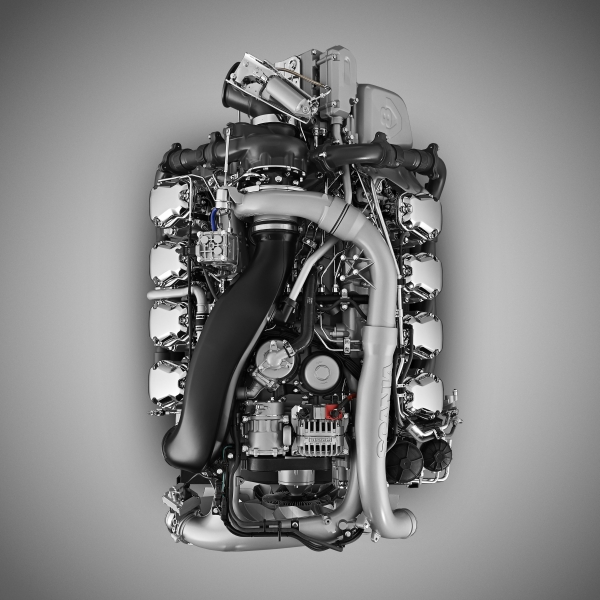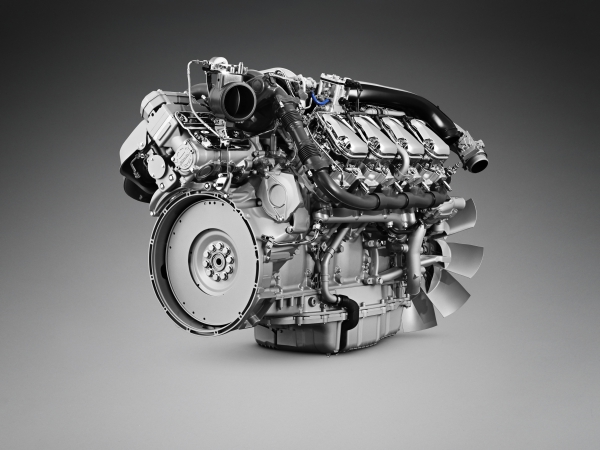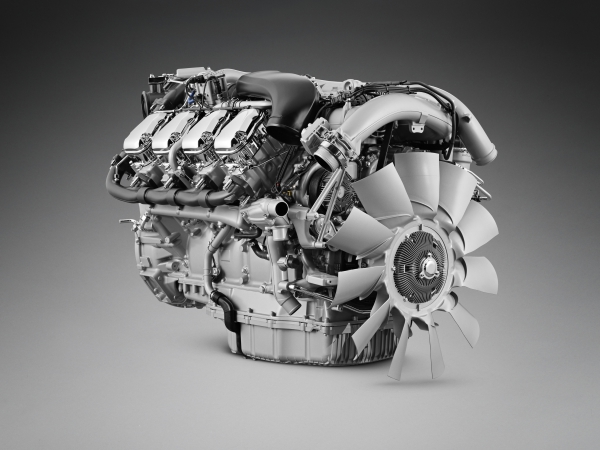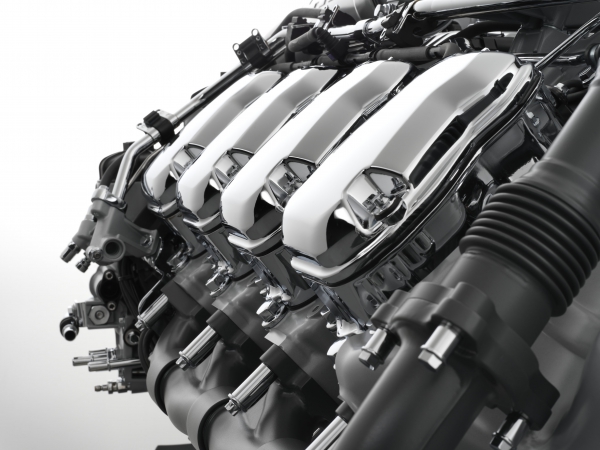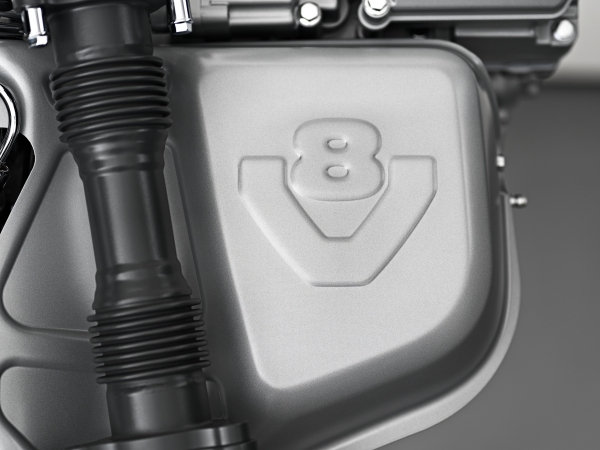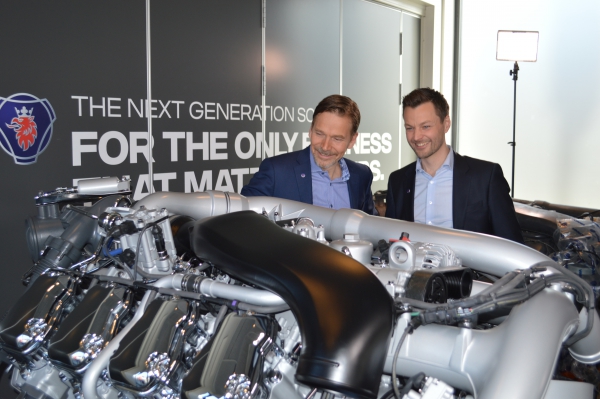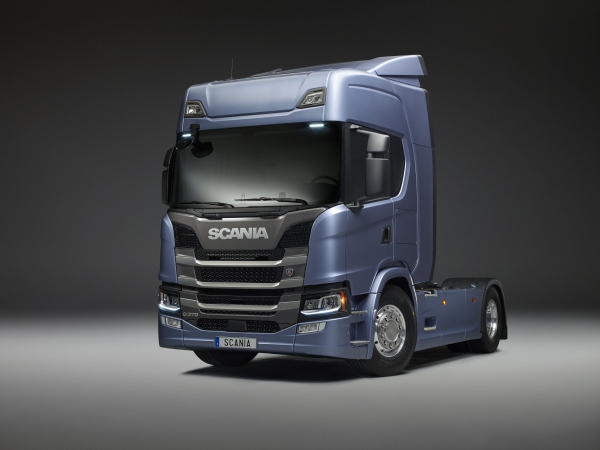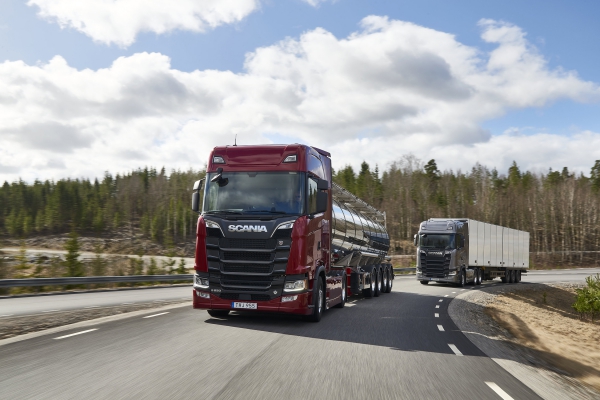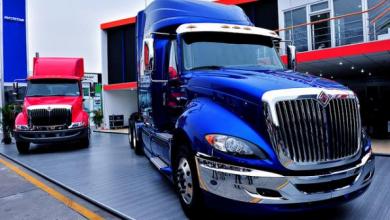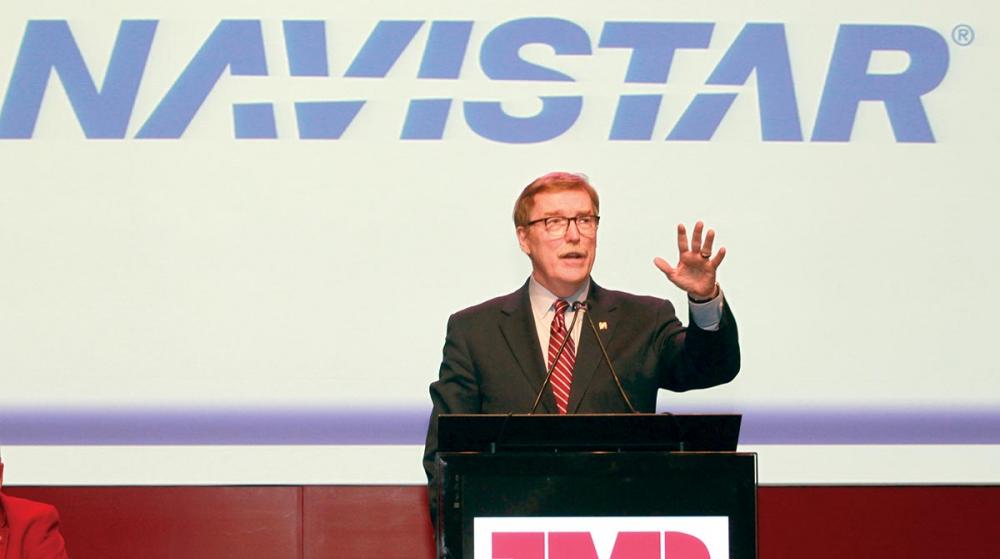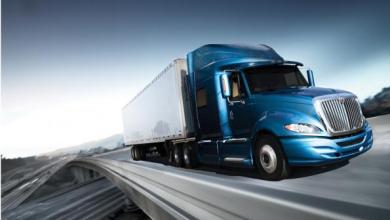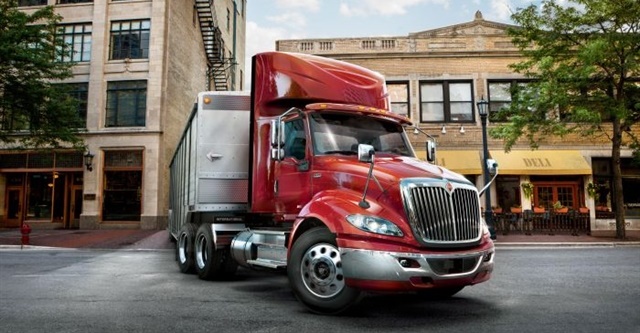
kscarbel2
Moderator-
Posts
18,871 -
Joined
-
Days Won
114
Content Type
Profiles
Forums
Gallery
Events
Blogs
BMT Wiki
Collections
Store
Everything posted by kscarbel2
-
Scania Group Press Release / June 8, 2017 Meet the “heartbeats” of Scania’s most recent masterpiece – the new V8 engine. For the past three years, this group of engineers, designers, project managers and product managers has overseen the new engine’s journey from 3D digital designs through plastic models to the magnificent machine you see here. Now there’s a new heart for the King of the Road. This is the team that made the beat go on. Kristoffer Klingberg Assistant Chief Engineer, R&D Johan Clason Product Manager, Marketing Daniel Ekholm Production Engineer, Production Didier Biwersi Project Leader, R&D Eric Ridström Object Manager, R&D Mikael Åkerfelt Development Engineer, Service .
-
Cummins launches crate engine program: Cummins Repower
kscarbel2 replied to kscarbel2's topic in Odds and Ends
New Cummins Crate Engines to Provide Enthusiasts with Clean, Powerful Alternative Cummins Press Release / June 8, 2017 CUMMINS NEW CRATE ENGINE PROGRAM, CUMMINS REPOWER™, WILL NOT ONLY GIVE TRUCK ENTHUSIASTS A POWERFUL ALTERNATIVE FOR THEIR OLDER ICONIC OR SENTIMENTAL PROJECTS, BUT A CLEANER, MORE FUEL EFFICIENT OPTION, TOO. “Without question, the environment is very important to Cummins,” said Jeff Caldwell, Executive Director of Cummins’ Global Pickup/Van Business. “We’re excited to provide enthusiasts with a cleaner and much more fuel-efficient engine than their original, or even a junkyard Cummins swap. “Cummins Repower will allow them to enjoy their iconic vehicles that much more,” he said. “There are certain vehicles people just won’t discard. We want to help make those vehicles as clean, reliable, economical and enjoyable as possible for many years to come.” The crate program was born after customer surveys identified significant demand for Cummins engines in the consumer aftermarket. Typically, the company’s engines are sold to truck manufacturers or truck fleets, often in large numbers. Cummins Repower is called a “crate” engine program because customers will be able to purchase engines in small volumes – as few as one – and they will arrive in crates. The first Cummins Repower offering will be the R2.8 Turbo Diesel, including an alternator, power steering pump, cam-driven vacuum pump, remote mounted oil filter and a universal wiring harness to ease the installation process for many different vehicle models. Initial testing focused on an R2.8 installed into an otherwise stock 2000 Jeep® Wrangler® in place of the Jeep’s original 4.0L gasoline 6-cylinder engine. The vehicle not only gained higher peak torque with the R2.8, but the amount of accessible peak torque across the RPM band also increased. In addition to the performance gains, preliminary testing indicates that the R2.8 more than doubled the fuel economy of the Jeep while meeting the Transitional Low-Emission Vehicle (TLEV) LDT2 emissions standards for that particular gasoline engine vintage. With mileage numbers of 30.8 mpg on the highway and 25.8 mpg in the city as compared to a stock 1997 Jeep Wrangler TJ with a 4.0L’s rating of 16-18 mpg highway, 13-15 city, the Cummins-powered Jeep had a carbon dioxide (CO2) emissions improvement of over 25 percent. The first end customer for the program worked with Anything Scout of Ames, Iowa (U.S.A.) to rebuild a 1967 Scout 800 on a modified brand new Jeep Wrangler chassis with all modern components. The company, which regularly uses V8 crate engines for their builds, was very happy with the performance and fuel economy of the R2.8 Turbo Diesel during a 3,500 mile “shake-down” run driving to the West Coast and back. “We have never seen better than 18 mpg with our fuel injected V8 swaps and we were thrilled to be getting 25 miles per gallon on the first long drive from Iowa to Arizona,” said Sean Barber, owner of Anything Scout. “We have customers who bring us their grandfather’s truck and ask us to restore it back to original looking condition, but they want them to also be usable so that’s when we transplant modern running gear under the classic steel,” he said. “These vehicles have large tires and aren’t aerodynamic – so to be getting 25 miles per gallon with no smoke or smell is amazing.” Certification work is underway using the California Air Resources Board’s (CARB) Executive Order process to ensure that every Cummins Repower engine sold has clear guidelines as to the specific vehicle classification and vintage for which it is qualified to be installed. Cummins is also working closely with the Specialty Equipment Market Association® (SEMA) and other key SEMA members to prepare the market for genuine Cummins Repowers. The SEMA Garage™ provides members the necessary access to the Cummins Repower products, enabling them to bring their own ancillary products to market, with the result for the enthusiast being a plug-and-play option for every step of the installation. Full production of the R2.8 is anticipated in the fall of 2017. Future engine family introductions into the Repower product lineup will be announced at later dates. There’s a bit of nostalgia in the program for Cummins, which really hasn’t sold engines in quite this way since the company’s namesake and founder Clessie Cummins was in charge. “Clessie Cummins repowered automobiles, race cars, buses and trucks, demonstrating the benefits of the diesel engine over their original power plants.” Caldwell said. “Nearly 100 years later, we are proud to be continuing the legacy of our namesake by enabling passionate enthusiasts to repower their iconic vehicles for the same reason Cummins repowered his own.” Photo: Anything Scout, an Ames, Iowa (U.S.A.) company, has seen significant fuel efficiency gains using the R2.8 Turbo Diesel to repower a classic Scout. . -
Navistar Defense Press Release / June 8, 2017 Navistar Defense 7000-MV is the world's more versatile medium-duty military truck. .
-
The Electronic Logging Device (ELD) Controversy
kscarbel2 replied to kscarbel2's topic in Trucking News
UPS seeks exemption from certain ELD mandate provisions Matt Cole, Commercial Carrier Journal (CCJ) / June 8, 2017 UPS (No. 1 in the CCJ Top 250) is petitioning the Federal Motor Carrier Safety Administration for an exemption from certain provisions in the electronic logging device mandate. The carrier is asking FMCSA to allow it to (1) use an alternative phase-in method for automatic on-board recording devices (AOBRDs) (2) for an exemption from the requirement that an ELD automatically records certain data elements upon a duty status change when a driver is not in the truck (3) to allow ELDs to be configured to a special driving mode for yard moves and (4) to allow vehicle movements of less than a mile on UPS property by non-driver UPS employees to be annotated in the ELD as “on property – other.” In the mandate, FMCSA allows carriers that have compliant AOBRDs installed before the Dec. 18, 2017, ELD compliance date to continue their use until as late as Dec. 16, 2019, before having to switch to ELDs. UPS says this grandfather clause applying to vehicles, rather than entire fleets, makes it difficult for large carriers to comply. The fleet says it plans to purchase more than 1,500 new tractors in 2018, after the grandfathering deadline, which would require all of those trucks to be equipped with ELDs. UPS says its drivers use multiple trucks each week and would inevitably end up driving trucks with ELDs and AOBRDs during the same week, creating “complex and difficult situations to manage.” UPS is asking FMCSA to allow it to install AOBRDs on new tractors that are delivered to facilities where AOBRDs are already in use to avoid drivers having to use both ELDs and AOBRDs. UPS says all of its vehicles would still be fully ELD-compliant by the Dec. 16, 2019, deadline. The second provision of the rule UPS is seeking an exemption from deals with ELDs recording data when a driver changes his or her duty status and when a driver logs in to or out of an ELD. Under the terms of a bargaining agreement for its drivers between UPS and the Teamsters Union, the fleet says it cannot comply with both the requirement that an ELD record tractor data when a driver logs in and out – or changes his or her duty status while outside the truck – as well as the bargaining agreement contract and pay guidelines for drivers. The fleet is asking FMCSA to allow it to “systematically annotate that the driver was performing other work” to assure accurate recording of on-duty, non-driving time. To save time for its drivers, UPS is also seeking an exemption to allow the drivers moving trailers around yards to be able to select the “yard move” special driving status and remain in that status, even if the truck is turned off and back on. The company says most of its drivers are required to complete yard moves as part of their regular work day, and UPS requires them to take the keys out of the ignition each time they exit the truck as a safety precaution. UPS says that under the exemption, if granted, the ELD would switch to a “driving” duty status if the truck exceeds 20 miles per hour or if it exits the geo-fenced yard. The fleet says requiring drivers to select “yard move” status each time they turn the truck off and back on would cost it approximately $460,000 a year in lost time. Finally, UPS asks that FMCSA make an exemption for its fuel and wash employees that are not technically drivers. The company says it has 1,434 employees to wash and fuel vehicles that only drive the trucks on UPS property and are not required to comply with hours-of-service regulations. Because the ELD rule requires the device to automatically record data when a truck is turned on and off – and UPS will be using portable, driver-based ELDs and not permanent ELDs in the trucks – providing the non-driver employees with ELDs would be costly. As an alternative, UPS proposes that truck usage of less than one mile by these employees driven completely on UPS property be annotated on an ELD as “on property – other.” FMCSA is seeking public comment on UPS’ exemption request, which can be made at www.regulations.gov by searching Docket No. FMCSA-2017-0054 once the document is published in the Federal Register on Friday, June 9. . -
Isuzu FTR Test Drive Addresses 4-Cylinder Engine Questions Heavy Duty Trucking / June 8, 2017 This week, Isuzu Commercial Truck of America offered the 2018 Isuzu FTR Class 6 cabover for limited driving at an event at Auto Club Speedway in Fontana, California. Similar events, attended by dealer sales, service, and parts staff; fleet customers, and media, were held in Chicago and New York. The redesigned Isuzu FTR is available for the first time since the model line was discontinued in 2009. The event, attended by Bobit editors of Work Truck Magazine, Heavy Duty Trucking, and Business Fleet Magazine, included a business briefing and product demonstration followed by closed-track test drives of the 2018 Isuzu FTR against competitive trucks. The tests included a cone course designed to exhibit the FTR’s handling and maneuverability and a timed “drag race” with competitive vehicles at maximum GVWR. The 2018 Isuzu FTR, rated at 25,950 lbs. GVWR, is available in one powerplant configuration, a 5.2L four-cylinder engine with an Allison six-speed transmission. The FTR is rated at 215 standard horsepower and 520 lbs-ft. standard torque. At the business briefing, Shaun Skinner, president of Isuzu Commercial Truck of America, highlighted the expected sales growth of the medium-duty segment in conjunction with U.S. population growth that will concentrate on urban centers. “The FTR is designed to meet the needs of moving cargo in urban centers,” Skinner said. Isuzu also unveiled results of comparative road tests conducted by Flexible Force LLC, an independent automotive testing and training company, in December 2016. The “blind comparative” tests, certified by the Sports Car Club of America (SCCA), measured the FTR’s performance in acceleration, braking, turning radius, and fuel economy. The FTR was tested against current models of Kenworth K270, Navistar 4300, Hino 268A, Freightliner M2, and Ford F-650. All vehicles were loaded to exactly 25,975 lbs., according to Roger Johnson, owner of Flexible Force LLC. The tests were conducted on a city route of 120.7 miles with 24 stops and a mountain route with a 6.5% grade and climbs from 1,500 ft. to 4,500 ft. Of the six vehicles, the FTR placed third and fourth in acceleration tests of varying miles-per-hour limits. In two braking tests, the FTR placed fourth and tied for third place. The FTR placed first in turning radius. Measuring fuel economy, the FTR won first place in both the mountain and city routes. In the city route, the FTR beat the next competitor by 16.1% and 22.3% over the last place finisher. “People that spend time in (medium-duty) trucks, their expectations have traditionally been that they’re going to run a six cylinder,” Johnson said. “You didn’t expect to run a four-cylinder; the technology just wasn’t there.” Johnson said the industry has seen incremental improvements in performance, emissions, and fuel economy with six-cylinder engines. “The next step in that improvement is displacement,” he said. “I believe in six to eight years a four-cylinder engine will be standard in Class 6. There is no comparative decrease in performance in a four-cylinder diesel truck engine today.” Production of the 2018 Isuzu FTR began May 8 at Isuzu’s Charlotte, Michigan, plant. Isuzu expects to ship orders in mid-June. .
-
When emotion meets logic – the new Scania V8
kscarbel2 replied to kscarbel2's topic in Trucking News
The short answer (drum roll here).............is no. MAN has a long history of selling (licensing) its truck technology (China a case in point). Scania on the other hand has, like the former Mack, always worked to protect its proprietary technology. It's never been for sale. And why would it.......you'd only devalue the Scania product. The policy of VW Group has been to grant Scania a great deal of autonomy, justified by the truckmaker's world leading technology and high profitability only matched by Paccar. MAN, owing to Germany's governmental policies, barely makes money (alike the VW car brand for the same reasons). So VW is willing to sell MAN tech. Don't get me wrong, MAN makes a fantastically engineered truck with stunning quality. Navistar has an impressive new partner in every regard. -
Scania Group Press Release / May 3, 2017 .
-
Scania Group Press Release / June 7, 2017 Karl Skilton knows the deserts of the Middle East so well that he can find puddles in them to give his Scania 143 a wash. And Karl’s Scania is so at home in the desert, he once left it there under the sand for a year and a half. Karl Skilton runs the Harleywood Haulage Company from a little village in Gloucestershire, England. He has six trucks, including two Scania R 480s and a left-hand Scania 143 from 1991 that has a 450 V8 engine. While he mostly transports silos and abnormal loads for construction work in the UK and Europe, he occasionally, “for a bit of fun”, makes the run to the Middle East on behalf of Astran. And for this, he always uses the Scania 143. “It’s the truck for the job,” says Skilton. “I bought it about eight years ago. I’d always liked the 143s and I’d had a few of them before. This time I wanted a left-hand drive, with a three-axle air spring suspension. I used to do Eastern Europe on the steel suspension trucks and get shaken to death, so I definitely wanted air suspension. The 143 ticked all the boxes. A left-hand Scania 143 “The 143s are a nice drive,” he adds. “They’re reliable and have plenty of power. They are also nice and simple on the electronics side. If you are going down to the Middle East, where there are not a lot of main dealers, it’s very helpful if you can keep it simple.” Before the current situation in Syria, Skilton had made about 15 runs to the Middle East, transporting things there that were needed in a hurry for the oil or gas fields. “We used to be able to do it in about two weeks, via Europe, Turkey, Syria, Jordan, Saudi Arabia and finally to Qatar. We used to have to go a bit.” Skilton doesn’t know the exact mileage of his 143 but he thinks it’s probably getting on to about 4 million kilometres by now. “It’s on its third engine, so it’s done quite a bit of work,” he says. “But there have been no real problems. The gearbox blew once in Saudi Arabia and I had to get towed to Qatar. But apart from that, nothing major. “I did a trip over to Qatar with it a couple of years back, and I couldn’t find a load to go back with, so I parked it in the desert for a bit, thinking I’d go back in a month or two. But it was about a year and a half in the end before I went back. When I did, I found it covered in sand. I jump-started it and then I drove it home. Every time I turned the heater on I got sand blasted.” On another occasion, Skilton managed to find a puddle in the desert to wash the truck and, embarrassingly, got the 143 stuck in it. “My mate said, ‘How have you managed to find a puddle that big in the Saudi Arabian desert?!’ I said I was looking for it all day and I got there in the end.” Astran Run The Astran Run first started in 1964, when the eponymous English company pioneered deliveries to Afghanistan, before adding the Gulf States to its list of destinations. .
-
Scania Group Press Release / June 8, 2017 Since midsummer 2016, Juha Lapatto has been test driving a Scania S 650 V8 6×4 Euro 6. He helps to ensure that the truck is tested to the limit on the tricky forest roads of Finland where he normally works. As a child, Juha Lapatto knew that he wanted to be a truck driver. His father drove trucks and Lapatto used to accompany him on some of the jobs. The younger Lapatto has now been a professional driver for twelve years, spending all but one of those years driving timber trucks for Finnish hauliers Aho & Nuutinen Oy. The company is based in eastern Finland and transports logs and other goods such as construction elements and building blocks. “A GOOD TRUCK TO DRIVE” Lapatto has enjoyed testing the new Scania. “This is a good truck to drive,” he says. “And it’s always nice to be in a new truck. The cab is more comfortable and the visibility is better than in the older vehicles,” he adds. His work involves transporting heavy timber loads off-road. He says that new technology has contributed to a better driving experience, as well as to reduced fuel consumption. “This truck performs exactly as it should; it meets my expectations,” he says, appreciating the fact that he has had an input into the development work. GOOD FACILITIES FOR SLEEPING Today, Lapatto is on a day shift about 150 kilometres from Kotka in eastern Finland. Working in the forest means he gets to see a lot of the local wildlife. “In my eleven years I’ve been out on many forest roads and I’ve seen almost all the forest animals, except the bear,” he says, laughing. Being a father of four, he prefers daytime work. Although the truck has good facilities for sleeping, at night he prefers to be home with his family. “I am grateful to my wife, who takes care of our four pre-school children,” Lapatto says. “She is very understanding when I do long hours.” But regardless of the demands of his work, he feels that it is a good fit for him. “A truck driver’s job suits people who like working independently and being on the road. It gives you freedom.” .
-
Scania Group Press Release / June 8, 2017 Per Hedmark transports everything – from houses to tyres – everywhere. He drives to copper mines north of the Arctic Circle and through forests and cities. His R 620 Euro 5 must be reliable in any weather and on any road. However, Hedmark is not satisfied. He is on the way to Norsjö, a village 300 kilometres north of Sollefteå, carrying 25-metre-long plastic pipes for a water pipeline that the municipality is building. It is minus 8 degrees Celsius, and large snowflakes are falling from the sky. But Hedmark prefers even more wintry winter. “It’s almost tragic that Örebro [a city far to the south] has more snow than we do here in Norrland,” he says. “I can see large bare rocks in the mountains, and that’s not the way it should be in February. I long for a trip on my snowmobile with my girlfriend behind my back and a feeling of floating on fresh snow. But that requires colder weather and more snow!” BIG DIFFERENCE IN PERFORMANCE Nevertheless, the mild winter has its advantages for Hedmark, who spends several nights each week sleeping in his truck. “As long as it’s above minus 20, it’s warm enough inside the truck,” he says. “If it gets colder, I let the engine idle, but that makes it more difficult to get a good night’s sleep.” Hedmark works for the Renfors Åkeri haulage company, based in Boliden, which mostly uses its trucks to transport ore. Some 26 trucks are used to carry loads from the mines in Malmbergen to the smelting plants in Boliden. Since the summer of 2016, Hedmark has been driving an R 620 Euro 5. He has been everywhere in it. From the copper mine in Aitik, 90 kilometres north of the Arctic Circle, to muddy forest roads and the busy Port of Gothenburg. Hedmark therefore needs a truck that he can rely on in any weather and on any type of road. “I transport anything from houses to tyres and tractors,” he says. “The total weight is 60 tonnes, and sometimes the trailer is 30 metres long and occasionally 4.7 metres wide. It is important that the truck can manage this, and so far I have been very satisfied.” The new V8 engine gives Per Hedmark 150 more horsepower than his old truck, an R 500. He has noticed a big difference in performance, but he thinks it is too soon to judge its fuel efficiency. “On average, I drive 2,500 kilometres per week. But the loads and routes vary so much that I just can’t estimate its fuel efficiency yet. Even a headwind can affect it.” FIRST FIELD TEST DRIVER ASSIGNMENT This is Hedmark’s first job as a field test driver, and he thinks it was great Renfors Åkeri offered it to him. After 12 years as a professional driver, he has solid experience that he can rely on. Driving a truck wasn’t Hedmark’s first career choice. “During my mandatory military service I wanted to become a tank driver, but I was too tall. So instead I got a truck driver’s licence. I was probably one of the last people who had the opportunity to do so. When I finished my military service, I had no other plans and it felt right to continue driving.” Hedmark quickly realised that a nine-to-five office job would not be suitable for him. He still thinks that the variety and freedom that life on the road offers are its biggest advantages. “I can plan my day however it suits me,” he says. “Sometimes I open my lunchbox in the calm of the forest. When I’m transporting houses, there are typically escort vehicles with me, and we are on the road for a couple of days so we spend some time together. But I always think that it’s nice when I can say goodbye and be by myself again.” COVERING SWEDEN Nevertheless, Hedmark does seek company during the time he spends driving – typically five days a week. “I use the telephone a lot during the day,” he says. “Talking on the phone is how me and my colleagues keep in touch and keep ourselves entertained as the road goes by. Other than that I listen to audiobooks. I prefer English ones – they have good background effects and you avoid bad translations.” He works all over Sweden, but Sollefteå in the north is his home. It is where he was born and raised and he has never seen any reason to move. “The town is the perfect size and offers everything I need,” he says. “But I’m not at home that often, so maybe I’m not the right person to ask.” .
-
Scania Group Press Release / June 7, 2017 When Scania put a 1992-vintage Streamline 143 head-to-head with a New Generation Scania S 500 in independent test drives, the improvements in terms of fuel consumption and emissions were clear cut. But the Series 3 classic still stood up well when it came to driving feel, according to one of the test drivers. Fuel consumption accounts for a significant proportion of running costs for all truck operators. This means that there’s considerable impetus to achieve ever higher levels of fuel efficiency. “Statistics show that fuel consumption has dropped by 1.3 percent a year since 2004 when we compare vehicles used in more or less the same way,” says Henrik Wentzel, a senior engineer at Scania. “At the same time, nitrogen oxide emissions have dropped significantly and constantly sit under the tough compulsory threshold. However, because pre-2004 vehicles didn’t have fuel and emissions monitoring systems, we don’t have figures for before this.” Rather than guessing about the development over longer periods of time, Scania decided to ask powertrain-testing company AVL to conduct an independent test. The company measured fuel consumption and nitrogen oxide emissions over six identical 140-kilometre test drives of a 25-year-old Streamline 143 and a newly manufactured New Generation Scania S 500. Scania 143 Both vehicles were designed for lumber transport and had 500 hp engines. The older truck had a V8 engine with a displacement of 14 litres, while the new truck had a straight six with a displacement of 13 litres. Despite its smaller size, the new engine was more powerful at all engine speeds. “We did it this way [using a straight six] because today’s V8s don’t come in such small sizes and we wanted to have as fair a comparison as possible,” says Wentzel. The test drives took place at the beginning of February 2017. The 143 had hardly been driven previously as it was an exhibit at the Scania museum in Södertälje. Apart from a necessary update of the tyres, it was effectively in the same mint condition as the S 500. During testing, the vehicles were driven at 85 km/h on the same stretch of road, at the same time, and by the same two drivers. They had the same cargo weight, which gave the new vehicle an advantage as it was lighter overall. Scania chose this method as it reflects the increased efficiency of modern vehicles. The drivers were forced to swap between the two vehicles so that the test results wouldn’t be influenced by who was driving. The fact that the drivers were – just by chance – father and son, Johan and Lucas Remmert, seemed almost symbolic. “The 3-series was a trip down memory lane for me,” says Johan Remmert who has driven trucks since the 1980s. “This was one of the trucks you really looked up to in the 1990s, and it actually stands up very well. It has real pick up in the lower gear range. And of course, there’s still a few out on the roads.” Johan Remmert continues, “Obviously, the new truck is better in terms of noise and comfort, but at the same time, it feels a bit like the driver just goes along with the truck. In the 143, you’re really driving the truck; you need to listen to the revs and change gear. You enjoy it in a different way. If I wanted to take a nice Sunday drive, then I’d take the old truck.” Test-drive results Lucas Remmert, who wasn’t born when the 143 was produced, adds, “The oldest truck I’d driven up until now was a 2000 model. But I felt this one went really well, even if I do prefer the new one.” The test results show that in the 24 years between the production of the two trucks, fuel consumption fell by about 25 percent. Nitrogen oxide, meanwhile, fell by 95 percent. “It’s confirmation that the improvements that we are gradually introducing produce consistent results over time,” says Wentzel. “That’s the way it is with the development of diesel engines. There’s no revolutionary fix for everything, and instead it’s all about working hard on the details.” He points to a long list of factors behind the change. Engines have become more efficient, as well having greater torque and power for their size. Aerodynamics have been improved, automated gear boxes reduce fuel consumption, rear axle ratios are lower, lubrication of gear sets is better, and curb weights are lower. “Although, in terms of power, the Streamline 143 still works well today,” Johan Remmert maintains. Exhibit at work In 1991, a new 14-litre V8 diesel engine with 500 hp electronic diesel control (EDC) hit the market. Due to its higher compression ratio of 17:1 and the introduction of EDC, the engine complied with the new emission regulation Euro 1 that was introduced in Europe in 1993. To cope with the new engine’s high torque, the new 12 speed range-splitter model GRS 900 transmission was introduced together with ASR (automatic anti-slip regulation). “It’s the truck of an epoch. It features some of the great technical progressions,” says Robert Bengtsson, Museum Technician at Scania Södertälje. When it comes to the design, the forward-controlled Streamline cab was big news. The cab had very low air resistance with a drag coefficient value of 0.5 percent – a reduction of 12 to 15 percent compared to the previous cab – which lowered the fuel consumption by 4 to 5 percent. Now part of Scania’s museum in Södertälje, this particular truck was purchased by Lönnerhedens Åkeri in 1991 and began its service in 1992. The truck journeyed 1,090,000 kilometres, mainly carrying pulpwood in the south of Sweden. The engine and the gearbox are still the original versions. Fact sheet Type: R143 Axle distance: 4.60 metres Gear box: GRS 900 Engine: 14-litre engine with EDC Power (max): 500 hp Torque (max): 2,130 Nm Scania 3-series The 3-series won Truck of the Year in 1989. The Scania Museum was established in 1971 and has around 80 exhibits, including trucks, buses, cars, engines, bicycles and train wagons. .
-
Scania Group Press Release / June 8, 2017 Scania V8 trucks are made for drivers and operators who demand high average speeds, enduring value and power. The new generation V8 offers all of these qualities – and improves the owners’ profitability. SIMPLIFIED YET REFINED Scania is continuously improving its products. And the all-new V8 engine is another leap forward in the company’s offering. The new V8 builds on many of the successful features from the earlier generations. But this time, out of approximately 650 components that make up the entire engine, 200 are completely new. The cross-functional team that developed the new V8 engine focused on four key areas: fuel efficiency to improve customers’ profitability, serviceability to increase the vehicles’ uptime, improved production processes to increase quality for even better robustness, and a contemporary design to match the New Generation Scania trucks. FUEL EFFICIENCY AT THE HEART Several factors have contributed to improved fuel efficiency, such as reducing the number of components and introducing components that are engaged only when needed. In the following paragraphs the most important ways that a better fuel-efficiency has been achieved are highlighted. LOAD-CARRYING CAPACITY While the 16.4-litre cylinder block remains the same, the complete engine weighs approximately 80 kilograms less than its predecessor. This is mainly due to a simplified engine layout with fewer parts overall – for example, the exhaust gas recirculation unit has now been removed. Consequently, the new V8 trucks have a higher load-carrying capacity. SCR ONLY – MADE POSSIBLE BY THE NEW EXHAUST GAS AFTERTREATMENT SYSTEM The new V8 engine meets emissions legislation together with decreased fuel consumption by increased aftertreatment efficiency. This has optimised the engine for fuel efficiency and power to a larger extent than when partly reducing emissions with exhaust gas recirculation (EGR) and conventional aftertreatment system. This also results in better engine breathing, which helps to improve fuel consumption. The new aftertreatment system includes improved evaporation, improved SCR catalysts (selective catalytic reduction) and an improved diesel particulate filter. The new aftertreatment system is an enabler for reaching Euro 6 emission levels without the need for an EGR. ROTATED TWIN SCROLL FIXED GEOMETRY TURBO The new rotated twin scroll fixed geometry turbo is common in the racing industry, but this is its first use in the heavy vehicle industry. The fixed geometry increases efficiency and results in a 0.5 percent reduction in fuel consumption. The new turbo unit also allows for a higher boost pressure, resulting in improved combustion. The turbo unit also helps reduce the overall weight of the engine. This is because the exhaust manifolds meet in the turbine housing from both sides instead of meeting in the turbo manifold, as they did in the previous generation, which was a more expensive and heavy solution. With the introduction of a single bank exhaust gas manifold, the overall weight of the engine has been reduced, while at the same time the legendary V8 sound has been improved. VARIABLE COOLANT PUMP The coolant pump utilises a viscose coupling that is only engaged when needed. This results in adjustable cooling, which means that less coolant is pumped through the engine when it is not needed. Lower friction losses and the reduced energy used for pumping help to decrease fuel consumption by up to 0.5 percent. PILOT-CONTROLLED OIL PUMP The new pilot-controlled oil pump adapts the oil pressure to the necessary amount at every moment. This helps to minimise the friction losses in the engine and results in a 0.5 percent reduction in fuel consumption. OIL THERMOSTAT The introduction of an oil thermostat has reduced the fuel consumption between 0.5 and 1 percent. The thermostat provides faster oil-pressure build-up during cold starts and, more importantly, maintains an optimal oil temperature under normal operation. MILLER CAMSHAFT The Miller camshaft used in the new 520 hp V8 engine reduces airflow through the engine at low load. This in turn increases the exhaust temperature, which helps to reduce the fuel consumption by 0.5 percent. At high load, compression work is moved out from the engine to the turbo compressor. More energy is extracted from the exhaust gases, which increases engine efficiency. This is possible because the inlet port is held open for a longer time and the effective inlet stroke is shorter than the expansion stroke. This will over-expand the in-cylinder gases, with more power to the crankshaft for the same amount of fuel. CLUTCH COMPRESSOR The new clutch compressor engages automatically when needed. This helps to reduce fuel consumption by approximately 0.5 percent, while at the same time reducing noise emissions. INCREASED SERVICEABILITY The completely new engine layout gives service technicians better access to the engine when servicing a vehicle. This means a more robust engine and reduces the time spent in the workshop, thus helping the vehicle owner achieve higher profitability. The development team left no stone unturned in its quest to improve serviceability. The new single high-pressure rail, for example, makes failure diagnostics easier, which improves the vehicle’s uptime. And the slotted holes on the intake manifold flange also make life easier for the service technicians should they need to remove the intake manifold for some reason. With the slotted holes, only the two top screws need to be loosened completely; the two lower screws will support the heavy intake manifold while it is being worked on. IMPROVED PRODUCTION PROCESS The development team has optimised the manufacturing process and introduced small but ingenious solutions to minimise the risk of mistakes in the assembly. One example is a small mesh grid covering a hole where there was a risk of losing small objects that could harm the engine. In the process, care has also been taken to improve the ergonomics for the people actually building the engine on the production line, the slotted holes on the aforementioned intake manifold being one contribution. The end result is an engine with an even higher quality than previous generation engines. CONTEMPORARY DESIGN The new engine layout in itself makes the engine look different. Details such as the rocker covers, charge air pipe, heat shield and high pressure pump have also been designed to visually fit the New Generation Scania trucks. IMPROVEMENTS IN CURRENT ENGINE PLATFORM The new V8 engine platform ranges from 520 to 650 hp. The current engine platform will still be used for the 730 hp version Scania V8 engine. It has, however, not been left untouched. The updated 730 hp will for example feature the pilot-controlled oil pump, the variable water pump and the new larger aftertreatment system as well as an updated engine management system, which will improve its fuel efficiency – especially at low load. .
-
Scania Group Press Release / June 8, 2017 When Scania says it’s presenting a new vehicle or engine, the word ‘new’ is used with some qualification. Products must undergo a long and arduous journey through computer calculations, component testing and field tests within Scania Research and Development before finally arriving on the market. DIGITAL COMPONENTS By the time Scania’s new generation V8 engines make their public debut they will have undergone thousands of hours of testing, and vehicles equipped with the engines will have covered millions of kilometres. The road to public release is a long one. The above figures however only apply to components that are unique to the V8 engine, such as the crankshaft and engine block. Thanks to Scania’s modular system, its V8 engines share components with many of the company’s other engine platforms, and these parts have already undergone extensive testing. Every single component in the V8 engine starts out as a model on a computer. And with the help of advanced computational models, the development team is able to quickly produce a limited number of alternatives that it believes should be tested in real life. Carrying out calculations with computers saves time. A lot of time. With physical testing it’s possible to conduct two or three different design iterations per year. Through the use of computer-based testing, a similar number of iterations can be tested in a week. ENTERING THE REAL WORLD Once a component leaves the virtual world and is produced in physical form, it is subjected to load in a controlled manner until it breaks or loses its function in some other manner. When a component breaks, the team investigates exactly what happened and transfers this knowledge across to the computer-based model. In this way, the accuracy of the model is verified and the understanding of why something doesn’t work increases. Once a component meets the design brief, it’s time for it to be tested together with other components. One way to do this is in so-called test cells, where over the course of 1,000 hours engines are exposed to stresses and changes corresponding to those they would experience throughout their working life in trucks. This process is called accelerated testing. This means, among other things, that the engine is subjected to higher power and significantly higher cylinder pressure than it’s built for. This allows for quickly identifying potential weak spots. TESTING THE COMPLETE VEHICLE Once an engine survives testing in the test cells, it is put through strenuous endurance testing in a vehicle. The endurance tests involve assessing how wear and tear affects the whole design, while function testing is used to check the fuel consumption, emission levels and drivability and that the engine delivers the intended performance. Finally there’s customer testing, in which a cross section of customers has the opportunity to contribute their view during field tests. .
-
Scania Group Press Release / June 8, 2017 Driving a Scania V8 has always been a reason for pride, and it has always been the starting point of an experience filled with emotions. Scania’s new generation of V8 engines combine these emotions with rational and logical reasons to buy and drive the king of trucks. Our goals for the new V8 reflect the way that the transport industry is currently developing. In the shift towards more intelligent and sustainable transport systems, longer and heavier vehicle combinations are gaining ground. Consequently, there is a growing demand for more powerful and fuel-efficient truck engines. And the fuel consumption figures for our new generation of V8s speak for themselves. These new state-of-the art engines reduce fuel consumption by between seven and ten percent. We have not seen such an improvement in fuel economy in our engine development for the past 50 to 60 years! Fuel economy When the Euro 6 emission standard was introduced quite a lot of weight was added to the engines of heavy vehicle. These new V8s are 80 kilos lighter than the current Euro 6 V8 platform, which is great news for customers that are paid per kilo transported – they will see the difference when calculating their total operation economy. With the introduction of new power levels in our V8 range, many customers operating heavy duty vehicles will find themselves a new favourite. These engines are the new benchmark within the transport industry. Their efficiency, robustness and strength beat everything. This is an engine whose development is at the very forefront of engine technology. To me, someone who is helplessly in love with that rumbling V8 sound and the feeling of power and potency when pulling 60 tonnes in a long uphill, it sounds like this new generation of V8s is precisely when emotion meets logic… . .
-
Scania Group Press Release / June 8, 2017 First G20 sleeper cab for long-distance trucks New-generation inline 9-litre engines Scania’s services are the key to customer profitability Scania is continuing with the major roll-out it began last year, with more and more services and products going into production and being launched to customers. The order books are now open on a new generation of Scania’s robust, five-cylinder engines, as well as the first variants of the new G cab. A number of services and performance enhancements are also being introduced, with most sharing a focus on improving productivity and total operating economy for European long-distance and forestry trucks. “Scania has significantly more on its introduction schedule for 2017 than there was during the extremely intense 2016 launch,” says Alexander Vlaskamp, Senior Vice President, Sales & Marketing, Scania Trucks. “We’re now rapidly filling our new range with products and services so that the majority of customers can tailor solutions around Scania’s new generation of trucks, regardless of what application their truck is used for.” When in 2016 Scania embarked on its biggest launch ever, the common themes linking the introduction were connected services, products for long-distance operations, and sustainability. Now the journey down this path continues with the introduction of more choices and solutions as production gets underway. Up until now, Scania has only released a small proportion of all the pending innovations, and only in Europe. “We live in an exciting time,” says Alexander Vlaskamp. “The response to the new generation has been extremely positive and has included everything from awards to wins in important press tests, along with a strong flow of customers leading to increased sales and new records.” The fact that Scania is now offering a greater range of specifications doesn’t mean that the company has lowered its targets as the launch goes forward. Scania places a high value on face-to-face interactions with customers and on its message that it has a total focus on customers’ businesses and profitability. “The next press and customer events will come after the summer and will be a truly holistic experience together with the Scania family,” says Vlaskamp. “I can reveal that we will then be focusing particularly on those applications operating with the toughest challenges, and also on how Scania’s focus on tailor-made solutions can grow customers’ profitability.” .
-
Scania Group Press Release / June 8, 2017 Scania is introducing a new generation of Euro 6 V8 engines that represent a new standard in fuel consumption. The engines, which are available at 520, 580 and 650 horsepower, can reduce fuel consumption by 7 to 10 percent for customers with vehicles that have higher combined truck and trailer weights, higher average speeds, or both. The new engine generation is Scania’s response to the growing trend in the transport industry towards heavier, longer trucks, and marks a new highpoint in the company’s engine building. The new 520, 580 and 650 engines join the 730 horsepower engine in providing customers with the best possible strength, robustness and productivity for maximum performance on the road. Each of the new V8s are characterised by advanced technical solutions that contribute to reduced weight, increased availability, and the eye-opening 7 to 10 percent reduction in fuel consumption. “Vehicle combinations with higher combined truck and trailer weights are a key factor in the shift to smarter transport,” says Alexander Vlaskamp, Senior Vice President, Sales & Marketing, Scania Trucks. “They are also the reason behind the trend towards an increased demand for more powerful truck engines.” Scania’s commitment to sustainable transport is at the heart of the new offering, but its V8 engines have always contributed to highly efficient transport solutions. The company’s focus has been on the lowest possible CO2-per-tonne ratios because fewer trucks are needed to perform the same amount of transport work. Ever since Scania introduced its first V8 close to 50 years ago, the engine family has been a favourite among demanding premium-level customers. While other high-performance engines have since come onto the market, none has had the sufficient robustness and appeal to rival the iconic position that Scania’s rumbling V8 engines have with experienced drivers throughout the truck world. With this latest new engine generation it is clear that Scania, unlike other legends, is not resting on its laurels. The company is continuing to develop its solutions all the time to stay at the forefront in productivity, driving pleasure, and attractiveness. .
-
http://media.navistar.com/index.php?s=43&item=379
-
https://www.bigmacktrucks.com/topic/45591-navistar-to-add-300-jobs-in-springfield-with-second-gm-deal/#comment-336068 https://www.bigmacktrucks.com/topic/49766-navistar-to-break-ground-on-12m-parts-distribution-center/#comment-369379
-
Sean Kilcarr, Fleet Owner / June 7, 2017 Export plan should pare down inventory of 7,000 trucks with MaxxForce 13-liter engines by end of 2018. An industry-wide surplus of used trucks in the U.S. is driving down the “price gap” between domestic and export valuations, which is spurring Navistar to shift sales of its bulging 7,000 unit inventory of trucks equipped with its discontinued MaxxForce 13-liter exhaust gas recirculation (EGR) only engine overseas. In a conference call to discuss the truck and engine maker’s second quarter earnings, Troy Clarke, Navistar chairman, president and CEO, said that “This is taking important step to put this legacy issue behind us … as legacy issues are masking our underlying improvement in results.” He added that if Navistar didn’t take advantage of the pricing equivalency now occurring in the export market – “and it is a hot market for us,” Clarke stressed – that 7,000 truck inventory would be with the company thru 2020 and beyond. “By this time next year, you’ll not hear us talking about this,” he stressed. “The pace of trade-ins [for legacy equipment] is exactly as anticipated. We’re past the 75% point and are now grinding through the balance. We’re going to take this drag on our earnings and put it behind us.” Walter Borst, executive vice president and CFO for Navistar, added that the $60 million charge the OEM took in the second quarter to beef up its “reserve” to cover those old MaxxForce trucks is action being taken “to eliminate the need to future reserve additions and to clear the way to eliminate the rest [of them] by end of 2018.” Borst added that if Navistar didn’t have to make that $60 million reserve allocation, its truck segment would have been profitable and the company’s overall results would have been closer to break even. “Values in export market are typically lower than what we achieve domestically, but in the past few years there’s been pressure on used truck prices for all brands, so that price gap narrowed,” he explained. “As result made decision to shift from domestic [used truck sales] to more aggressively pursue export opportunities,” Borst noted. “It will accelerate the velocity of [used truck] sales, drive [used truck] inventory lower, and make it easier for dealers and customers to sell their [used] MaxxForce trucks in the U.S. market. We believe our legacy EGR issues coming to an end.” .
-
Navistar Pins Q2 Loss on New Vehicle Sales, Used Trucks
kscarbel2 replied to kscarbel2's topic in Trucking News
Navistar Loses $80 Million in Second Quarter as Revenue Declines Transport Topics / June 7, 2017 Navistar International Corp. lost $80 million, or 86 cents a share, on revenue that declined to $2.1 billion during the fiscal quarter ended April 30, as the manufacturer also set aside an extra $60 million for its reserve fund to deal with used trucks with troubled engines that are largely exported. In a June 7 earnings call, Chairman and CEO Troy Clarke said the one-time charge is expected to be the last significant action needed to resolve issues related to the MaxxForce 13-liter engines that have enmeshed the Lisle, Ill., original equipment manufacturer since 2012, leading to net losses in 18 of the past 19 fiscal quarters. “Warranty and used truck issues from the MaxxForce 13 [exhaust gas recirculation] products continued to diminish, and now is the time for us to take steps to put these issues behind us faster,” Clarke said. Other executives on the call estimated it would take until the end of next year to wind down the MaxxForce issue completely. Navistar has met with increasing success in finding export homes for the used vehicles. Mexico was mentioned as a destination for the heavy-duty trucks in the earnings call, and a company spokesman said afterward that South and Central America and Southeast Asia are also important markets. “The trucks stay intact when they leave here,” said Navistar spokesman James Spangler. “But in the receiving countries, some of the components are de-contented to meet local emissions and fuel standards,” he said. Spangler would not specify which components are removed abroad, but the OEM’s domestic troubles were related to its choice of third-generation EGR to meet 2010 federal emissions standards. All North American heavy-duty truck makers now use selective catalytic reduction. A year ago, Navistar earned $4 million, or 5 cents, on quarterly sales of $2.2 billion. Quarterly truck sales were led by Classes 6 and 7 medium-duty vehicles, which rose to 7,000 units from 6,200 in last year’s quarter. Heavy-duty sales dropped to 5,300 for the quarter from 6,800. For the quarter, the company’s truck division lost $56 million on sales of $1.39 billion. In the comparable 2016 quarter, the loss was $23 million on revenue of $1.46 billion. Chief Financial Officer Walter Borst observed that without the $60 million reserve fund charge, the truck division would have posted a profit. Clarke and Bill Kozek, president of the truck and parts businesses, said they are “bullish” on the rest of this year, especially on heavy-duty sales. Clarke said that while medium-duty truck sales are front-loaded during a typical year, “Class 8 demand builds through the year.” He cited projections from market research firms forecasting better heavy-duty sales during the second half of this year, compared with the first six months. “We’re participating in the increase in the order intake as well. Our medium growth is significantly higher than the Class 8, but the Class 8 is holding its own,” Kozek said of the company’s trend on orders. “Our backlog is as far out as it’s been since [2013], so that’s a positive trend for us in the second half. But the other piece of that is customers are having pretty good years in general. And now they’re looking at vehicles for now and then into 2018,” Kozek said. In addition to his efforts at fixing Navistar’s previous problems, Clarke has emphasized the need to introduce new products to generate future sales. For on-highway Class 8 equipment, Navistar launched the LT tractor last year, the RH model in April and the 12.4-liter A26 engine in February. Clarke said his Class 8 backlog includes 1,500 trucks with A26 engines. . . -
Navistar Pins Q2 Loss on New Vehicle Sales, Used Trucks
kscarbel2 replied to kscarbel2's topic in Trucking News
Navistar takes $60 million used truck charge Fleet Owner / June 7, 2017 OEM plans to export more of its “legacy” MaxxForce-equipped vehicles to help reduce its used truck inventory. Truck and engine maker Navistar posted an $80 million net loss for the second quarter on revenues of $2.1 billion, with higher losses in its used truck business the main culprit. The company said in its earnings release that it took a $60 million charge in the second quarter to beef up the “reserve” for used trucks equipped with the OEM’s “legacy” MaxxForce 13-liter engines – wiping out the $47 million in earnings before interest, taxes, and amortization (EBITA) it booked for the quarter. Navistar stressed that the used truck situation “was the largest contributor to the year-over-year decline in profits” in its release. The company pointed out, though, that it is “changing its sales strategy” for MaxxForce 13-liter equipped used trucks to “take advantage of additional opportunities to sell more units into export markets,” a move it expects will accelerate efforts to reduce its inventories of those vehicles. "We are on track to improve on last year's results, but still have quite a bit of work to do in the second half," noted Troy Clarke, Navistar’s chairman, president and CEO, in a statement. "However, the work we've done in the first six months growing share, building our backlog, and managing costs, combined with improving industry conditions, positions us to deliver a stronger second half," he added. Other items Navistar noted in its second quarter earnings release include: Revenues of $2.1 billion in the second quarter were down 5% compared to $2.2 billion in the same period last year, a decrease that primarily reflects lower volumes in the company's “core market” of Class 6-8 trucks and buses in the U.S. and Canada. Navistar’s truck segment net sales declined 6% to $1.4 billion in second quarter compared to second quarter of 2016, due to lower core volumes, the impact of a shift in product mix in the company's core markets, and the cessation of sales of CAT-branded trucks units sold to Caterpillar. This was partially offset by an increase in Mexico truck volumes. Overall, Navistar said its truck segment loss increased to $56 million in second quarter versus a loss of $23 million in the same period a year ago, again driven by the higher used truck losses, market pressures, and the impact of lower core market volumes. Parts segment second quarter net sales dipped 6% or $37 million to $610 million, driven by lower sales from Blue Diamond Parts (BDP), the company's parts joint venture with Ford, as well as by lower U.S. and export volumes, partially offset by higher U.S. and Canada parts sales related to Fleetrite brand and remanufactured parts sales. Yet Navistar noted its parts business made a profit of $153 million in second quarter, though that’s down 13% versus the same period last, primarily due to margin declines in BDP and the company's North American markets. The company’s global operations segment witnessed a 9% dip in net sales to $70 million in the second quarter compared to same period in 2016, losing $7 million versus a loss of $1 million last year. Navistar cited lower volumes in the company's South America engine operation due to the continued economic weakness in the Brazil economy for those declines. Outside of those results, Navistar noted that ended the second quarter 2017 with $949 million in consolidated cash, cash equivalents and marketable securities on hand, with two “significant” wins for its defense division bolstering its bottom line: two foreign military contracts to reset, upgrade and support 1,085 long wheel base MaxxPro mine resistant ambush protected (MRAP) vehicles and to produce and support 40 MaxxPro Dash DXM MRAP vehicles for foreign military sales. The company is also expecting full “run-rate” production of General cutaway G van for General Motors at Navistar's Springfield, OH factory, to help generate more revenues as well. Lastly, Navistar reiterated that it expects retail deliveries of Class 6-8 trucks and buses in the U.S. and Canada to be in the range of 305,000 units to 335,000 units for fiscal year 2017. . -
Heavy Duty Trucking / June 7, 2017 Navistar International Corp. (NYSE: NAV) reported a second quarter 2017 net loss of $80 million on revenues of $2.1 billion. The truck and engine maker attributed those results to lower U.S. and Canada sales of its trucks and buses and to heightened used-truck losses. Revenues in the quarter were down 5% (compared to $2.2 billion in Q2 2016), according to the company’s June 7 earnings release. Navistar said that decrease “primarily reflects lower volumes in the company’s core (Class 6-8 trucks and buses in the United States and Canada) market, where chargeouts were down 5%, but [were] higher than industry core market volumes, which were down 13% year-over-year.” Navistar also reported that higher used truck losses led it to take a $60 million charge in the second quarter, pointing out that its inventory of “legacy” MaxxForce-13-powered used trucks was the largest contributor to the year-over-year decline. As a result, the company stated it is changing its sales strategy for these units, trying to sell more units into export markets, "a move it expects will accelerate efforts to reduce its inventories of these trucks.” The Q2 results also included $18 million in adjustments, primarily from pre-existing warranties, asset impairment charges, restructuring of manufacturing operations, and debt financing charges. “We are on track to improve on last year’s results, but still have quite a bit of work to do in the second half,” said Troy A. Clarke, Navistar chairman, president and CEO. “However, the work we’ve done in the first six months growing share, building our backlog, and managing costs, combined with improving industry conditions, positions us to deliver a stronger second half.” Navistar reported that Q2 EBITDA was $47 million, compared to $135 million a year earlier. It also said that it ended Q2 with $949 million in consolidated cash, cash equivalents, and marketable securities. Manufacturing cash, cash equivalents and marketable securities were $918 million at the end of the quarter. Other highlights of the earnings release, as stated by Navistar, include: Improving core market share, with additions to the company’s production schedule and extensions of the company’s backlog into the fourth quarter. Strengthening competitive presence in the Class 8 market, including ramped-up deliveries of the new International LT Series with the Cummins ISX 15L engine; introduction of the new RH Series of Class 8 regional haul tractors; and unveiling of the new International A26 12.4L engine, which launches in the LT and RH Series in the coming weeks. Significant defense wins, including two foreign military contracts to reset, upgrade and support 1,085 long wheel base MaxxPro Mine Resistant Ambush Protected (MRAP) vehicles; and to produce and support 40 MaxxPro Dash DXM MRAP vehicles for foreign military sales. Progress on new sources of revenue, including full-run-rate production of General Motors’ cutaway G van at Navistar’s Springfield, Ohio, plant; expansion of Navistar’s connected vehicle services under the OnCommand Connection brand, which now includes more than 300,000 subscribers; announcing its Electronic Driver Log app, which will assist smaller fleets and owner-operators in complying with new federal regulations; and the unveiling of OnCommand Connection Marketplace, a new, open-architecture, cloud-based technology platform for a broad range of driver support tools and applications. Closing its wide-ranging strategic alliance with Volkswagen Truck & Bus, under which the two companies are already collaborating on a number of potential technology projects, and in a procurement joint venture, which is identifying cost-saving opportunities and is expected to be accretive year one. Naming Persio V. Lisboa as executive vice president and chief operating officer. “Persio played a key role in creating our alliance with Volkswagen Truck & Bus, and led many of the initiatives to improve our operations during the turnaround,” Clarke said. “His focus in this new role will be to build on the progress we’ve made over the last four years.” Navistar also reiterated its 2017 guidance, including its forecast that retail deliveries of Class 6-8 trucks and buses in the U.S. and Canada will be in the range of 305,000 to 335,000 units for fiscal year 2017. The company added that full-year 2017 revenues are expected to be similar to 2016; full-year 2017 adjusted EBITDA is expected to be higher than 2016, and fiscal year end 2017 manufacturing cash is expected to be about $1 billion. .
BigMackTrucks.com
BigMackTrucks.com is a support forum for antique, classic and modern Mack Trucks! The forum is owned and maintained by Watt's Truck Center, Inc. an independent, full service Mack dealer. The forums are not affiliated with Mack Trucks, Inc.
Our Vendors and Advertisers
Thank you for your support!


